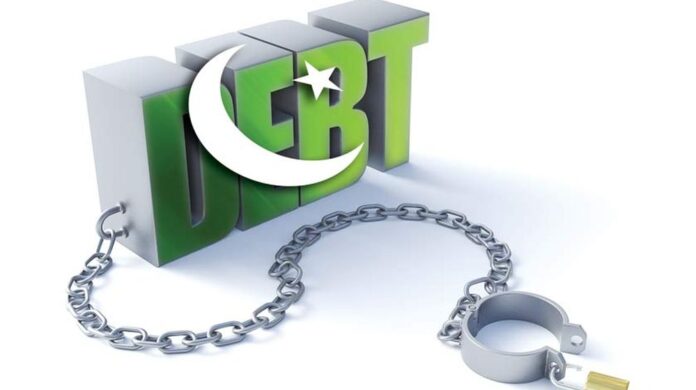Pakistan is sinking rapidly. Exclusive Article published in The Truth International magazine
ISLAMABAD: After the approval of the IMF loan, everyone in the country and abroad was anticipating economic revival and stability in Pakistan. However, things have gone the wrong way and the economy of Pakistan has, once again, landed into reverse gear especially after the formation of caretaker government. The foreign exchange reserves, stock market, remittances, exports, and value of rupee are steadily declining with the passage of time.
In recent days, the KSE-100 index has lost more than 4,000 points, falling to 44,450 points on Thursday (August 30) while the rupee has plunged to 327 rupees versus the US dollar in the open market trading, from 292 rupees when the caretakers came to power. Most of the other key economic indicators are in a similar state of decline, demonstrating that economy of Pakistan is sinking rapidly.

Additionally, the business community, exporters, industrialists, and consumers are bemoaning the IMF-driven frequent increase in power, gas tariffs, and hikes in domestic petroleum prices. This situation is dragging the country towards an economic mess day by day. It appears that in the next three to four months, once again Pakistan will be struggling with the default-like situation. The ongoing IMF program is expiring by March 2024, but before that, the economy of the country and the consumers, including business persons, will be in serious trouble just because of the rapid deterioration in the key economic indicators especially the regular devaluation of the rupee.
On August 31, 2023, the dollar-rupee exchange rate widened to 330 rupees in the open market trading. It shows an increase of 38 rupees since August 9, 2023, when the previous government dissolved the National Assembly. At that time, the dollar-rupee exchange rate was fluctuating around 292 rupees. However, in the inter-bank trading, the exchange rate of the dollar to a PKR increased by 18 rupees during this period as it increased to a record high mark of 305 rupees on August 25, from 287 rupees on August 9, when the Shehbaz Sharif-led government hand over power to the caretakers.
Notably, when the IMF released $1.2 billion for Pakistan on July 13, a day after its board approved a stand-by arrangement for Pakistan, at that time the dollar-rupee value was hovering around 278 rupees in the inter-bank and 282 in the open market trading. Nevertheless, as the IMF has linked its bailout program with the free float of the dollar and curb-free imports, the value of the dollar has surged to a record high level these days.
Surprisingly, after the approval of the IMF loan for Sri Lanka, the value of the Sri Lankan has improved to 320 rupees to a dollar. However, in the case of Pakistan, the situation has moved in the wrong direction after the release of the IMF loan. It is a fact that some of the IMF’s conditions are constantly derailing the economy of Pakistan and making life miserable for consumers and business persons across the country. As much value, as the US dollar gains, so much pain will be passed on to the consumers. And it is the law and dictation of the IMF.
Current Account Deficit Widens in July 2023: Pakistan is sinking
The current account figures for July 2023 indicate that the policymakers might be haunted by the state of the current account balance. After maintaining a positive trajectory for four consecutive months and achieving a surplus of $334 million in June, which contributed to a cumulative surplus of $1.4 billion from March to June 2023, the trend has now reversed. In July 2023, the current account deficit reached $809 million, marking the highest deficit since FY23 and raising concerns about the already fragile economy.
In comparison to the substantial current account deficit of $17.5 billion in FY22, the deficit in FY23 has shrunk by 85.14% to settle at $2.6 billion, primarily due to import restrictions implemented as a policy measure by the PML-N-led coalition government. Amidst low reserves and stalled talks with the IMF, the government pursued import restrictions, leading to a 43% reduction in the trade deficit to $27.55 billion, down from $48.35 billion in the same period the previous year.
Exports, Imports, and Remittances _ Pakistan is sinking
Imports also plummeted by 31%, settling at $55.29 billion compared to $80.13 billion in FY22. Conversely, export earnings failed to show a significant increase, reaching $27.74 billion, a decrease from $31.78 billion in FY22. Remittances also slowed down, falling to $27 billion from $31.3 billion during the same period last year. This strategy aimed to align import expenses within the range of export and remittance earnings.
Given the growing deficit in July 2023 and the anticipated challenges ahead, it’s clear that the current account deficit isn’t unprecedented. One of the conditions set by the IMF was the removal of import restrictions, a move that was expected to impact the country’s external account position and lead to mounting deficits. As the import backlog is cleared, this is likely to exacerbate the external account position at a time when exports are stagnant and remittances are subdued, partly due to the preference for informal banking channels by overseas residents.
While imports for July 2023 stood at $4.2 billion, the simultaneous decline of 12.7% in exports and 7.3% in remittances contributed to the current account deficit. Considering the current scenario, the country’s external account position is expected to worsen. The situation is further complicated by the rising prices of crude oil in the international market. With OPEC+ crude protection at its lowest point since August 2021 and the potential for higher prices due to the economic rebound in China, the pressure on import costs, particularly in the petroleum group, could strain the economy.
This pressure on the external account position is likely to lead to currency depreciation, as evidenced by the Pakistani Rupee crossing the 300/$ threshold. This situation will also test the stability of the country’s reserves, which are heavily reliant on funding from various sources including the IMF. If imports were to increase to a monthly average of $6 billion while exports and remittances remained unchanged, the situation could become even more challenging.
In the realm of Pakistan-IMF negotiations on circular debt reduction, the government engaged in a virtual meeting with the IMF to discuss energy sector losses and strategies to tackle circular debt during the current fiscal year. The aim was to find solutions to eliminate accumulating circular debt.
Circular Debt Crisis: Pakistan is sinking rapidly
To address circular debt, the Pakistani government made adjustments to fuel prices and introduced quarterly tariff revisions. They also shared a new Circular Debt Management Plan (CDMP) with the IMF. However, concerns were raised about the CDMP’s sustainability due to declining recoveries, prompting the need for an effective strategy. Despite agreements with the IMF, the stability of the Pakistani rupee remains a challenge. The rupee’s depreciation against the US Dollar has led to increased demand for imported items and a rush to purchase dollars. This trend has been further fueled by a surge in imports, contributing to the currency’s decline. The gap between interbank and open market rates has exceeded the recommended threshold set by the IMF. The decline in the local currency has implications for various sectors, including fuel, electricity, transport, and other goods prices. Despite the challenges, officials emphasize the potential for improvement as import payments decrease and regulatory authorities monitor unnecessary dollar purchases.
Declining Foreign Exchange Reserves
Moreover, the country’s total liquid foreign exchange reserves decreased by $131 million due to external debt servicing. The State Bank of Pakistan’s (SBP) weekly report indicated that total liquid foreign reserves stood at $13.24 billion as of August 18, 2023, compared to $13.38 billion on August 11, 2023. SBP’s reserves decreased by $125 million, while net foreign reserves held by commercial banks slightly declined by $6 million.
$601 billion Reserves of India
At present, the foreign exchange reserves of India have ballooned to $601 billion in August 2023, showing a significant increase in comparison with $578 billion reserves in March this year. The economy of India has been growing consistently, but the economy of Pakistan has been sinking steadily. Instead of repeating past mistakes, our “rulers” must learn something from India as both countries got independence simultaneously.
I am an experienced writer, analyst, and author. My exposure in English journalism spans more than 28 years. In the past, I have been working with daily The Muslim (Lahore Bureau), daily Business Recorder (Lahore/Islamabad Bureaus), Daily Times, Islamabad, daily The Nation (Lahore and Karachi). With daily The Nation, I have served as Resident Editor, Karachi. Since 2009, I have been working as a Freelance Writer/Editor for American organizations.










